Aan de slag
Deze paragraaf helpt je om MuseScore te installeren en in gebruik te nemen. Je zal ook leren hoe je een nieuwe partituur moet maken.
Installatie
MuseScore werkt op verschillende computer systemen inclusief Windows, Mac OS X en Linux.
Windows
Installatie
Je kunt het Windows installatie pakket op de Nonexistant node nid: 27 pagina van de MuseScore website downloaden.
Klik op de link om de download te starten. Je internet browser zal je vragen om de download te bevestigen. Klik Bestand Opslaan.
Zodra de download klaar is, dubbelklik het bestand om de installatie te starten. Windows kan nu een veiligheidsdialoog tonen waarin gevraagd wordt om te bevestigen of je de software wilt uitvoeren. Klik Uitvoeren om verder te gaan, je zult dan kort het volgende venster zien:
NOT FOUND: Win-Install-Wizard-1a.png
gevolgd door:
NOT FOUND: Win-Install-Wizard-1b.png
Als je dit niet ziet maar iets anders, dan is het mogelijk dat de .msi extensie niet gekoppeld is aan msiexec.exe. Je kunt de extensie koppeling oplossen, of gebruik maken van de verplaatsbare versie van MuseScore.
De installatie gaat verder met:
NOT FOUND: Win-Install-Wizard-1c.png
Als je op Cancel klikt, nu of later, dan zie je:
NOT FOUND: Win-Install-Wizard-2a.png
Als je op Next klikt om te verder te gaan, dan zal de installatie wizard de condities van de gratis software licentieovereenkomst tonen.
NOT FOUND: Win-Install-Wizard-2b.png
Lees de condities van de overeenkomst en zorg dat het vakje naast de tekst I accept the terms in the License Agreement is aangevinkt en klik op Next om verder te gaan. Nu moet de installatie locatie voor MuseScore worden bevestigd.
NOT FOUND: Win-Install-Wizard-3.png
Als je een nieuwe versie van MuseScore installeert en de oude versie wilt behouden op de computer, dan moet je de locatie wijzigen (versie 2.0 en 1.x kunnen naast elkaar worden gebruikt en overschrijven elkaar niet, hiervoor is geen aanpassing nodig). In andere gevallen klik op Next om verder te gaan.
NOT FOUND: Win-Install-Wizard-4.png
Klik Install om verder te gaan.
Geef de installatie wizard een paar minuten om de benodigde bestanden en configuratie te installeren. Je ziet het volgende scherm:
NOT FOUND: Win-Install-Wizard-5b.png
en als laatste:
NOT FOUND: Win-Install-Wizard-5c.png
Klik Finish om de installatie af te sluiten. Je mag het installatie pakket dat je hebt gedownload verwijderen.
Start MuseScore
Om MuseScore te starten, kies Start → Alle Programma's → MuseScore 2 → MuseScore 2.
Verwijderen
Je kunt MuseScore verwijderen in 32-bit Windows met het commando:
cd C:\Program Files\MuseScore
Uninstall.exe /S
en op 64-bit Windows met het commando:
cd C:\Program Files (x86)\MuseScore
Uninstall.exe /S
Foutopsporing
In Windows XP en Vista kan de installatie door het systeem geblokkeerd worden. Als je MuseScore niet kunt installeren, klik dan met rechts op het bestand dat je gedownload hebt en kies Eigenschappen. Als je de tekst ziet: "Dit bestand is afkomstig van een andere computer en wordt mogelijk geblokkeerd om deze computer te beveiligen", klik dan op "Blokkering opheffen", "OK" en dubbelklik nogmaals op het bestand.
Mac OS X
Installatie
Je vind het DMG (disk image) bestand op de Nonexistant node nid: 27 pagina van de MuseScore website. Klik op de Mac OS X link om de download te starten. Zodra de download klaar is, dubbelklik op het DMG bestand om het disk image te mounten.
NOT FOUND: Mac_Install.png
Sleep het MuseScore icoon naar de Applicatie map icon.
Indien je niet als administrator bent aangemeld, dan kan Mac OS X mogelijk om een wachtwoord vragen: klik Authenticate en voer het wachtwoord in om verder te gaan.
NOT FOUND: Mac_Install_2.png
Wanneer de applicatie klaar is met het kopiëren, verwijder dan het disk image. Je kunt MuseScore nu starten vanuit de Applicatie map, Spotlight of Lauchpad.
Verwijderen
Verwijder MuseScore uit de Applicatie map.
Linux
Zie de Nonexistant node nid: 27 pagina voor instructies behorende bij MuseScore op Linux. Pakketten zijn beschikbaar voor Debian, Unbuntu, Fedora en PCLinuxOS. Voor andere distributies is het nodig om de applicatie te compileren van de bron. Voor de instructies, specifiek voor Fedora, zie hieronder.
Fedora
-
Importeer de GPG sleutel:
su rpm --import http://prereleases.musescore.org/linux/Fedora/RPM-GPG-KEY-Seve -
Ga naar de Nonexistant node nid: 27 pagina van de MuseScore website. Klik op de link voor de stabiele Fedora download en kies het juiste rpm pakket voor jouw platform.
-
Afhankelijk van jouw platform, gebruik één van de volgende twee commando's om MuseScore te installeren
-
voor platform i386
su yum localinstall musescore-X.Y-1.fc10.i386.rpm -
voor platform x86_64
su yum localinstall musescore-X.Y-1.fc10.x86_64.rpm
-
Als je problemen hebt met het geluid, zie dan Fedora 11 en geluid
Zie ook
- Hoe kan ik de taal van MuseScore aanpassen
- Hoe kan ik MuseScore installeren zonder administrator rechten
- Hoe kan ik MuseScore uitvoeren als Administrator in Windows
Install on Windows
Install
If you're on Windows 10, MuseScore can be installed from the Windows Store. Clicking here will open Musescore's page in the Store app. There you will only have to click Get the app > and MuseScore will be downloaded and installed.
Otherwise you can get the Windows installer from the download page of the MuseScore website. Click on the link to start the download. Your Internet browser will ask you to confirm that you want to download this file. Click Save File.
When the download finishes, double-click on the file to start the installation. Windows may prompt you with a security window to confirm this before running the software. Click Run to continue, you'll then briefly see
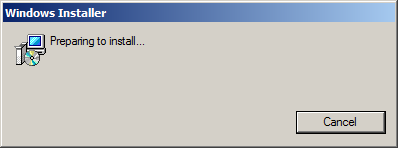
followed by
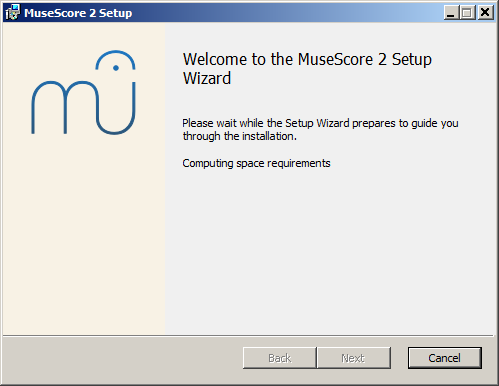
In case you don't see this installer window but something else, it's possible that the .msi extension is not associated with msiexec.exe. Either you can fix the association, or download and use the portable version of MuseScore instead.
Continuing you'll see

If you click Cancel, here or later, you'll see:
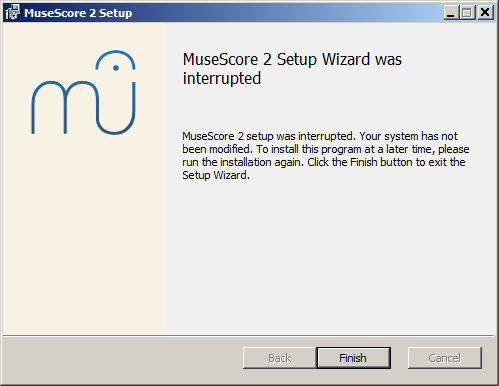
If instead you click Next to continue, the setup wizard displays the terms of the free software license.
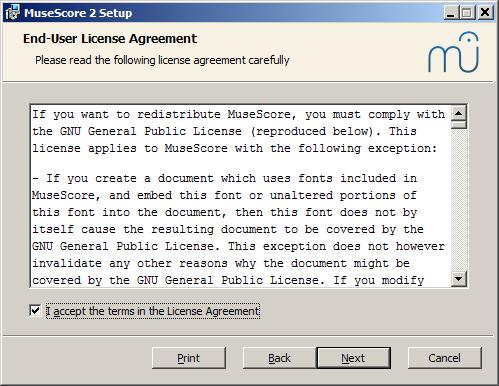
Read the terms of the license, make sure the box next to "I accept the terms in the License Agreement" is checked, and click Next to continue. Next the installer will ask you to confirm the location in which to install MuseScore.
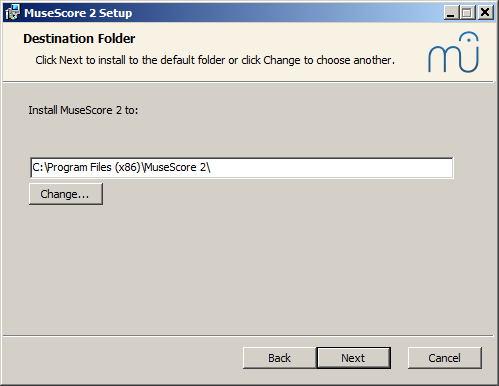
If you are installing a newer version of MuseScore but still want to keep the old version on your computer, then you should change the folder (note that MuseScore 2 can coexist with MuseScore 1 with no changes needed). Otherwise click Next to continue.
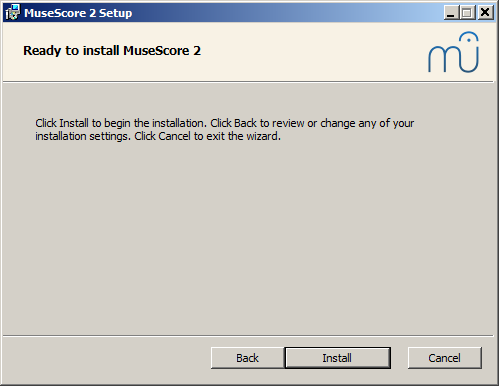
Click Install to continue.
Give the setup wizard a few minutes to install the necessary files and configurations. You'll see

and finally
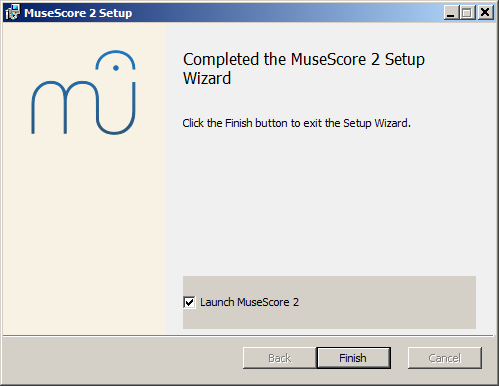
Click Finish to exit the installer. You may delete the installer file you downloaded.
Start MuseScore
To start MuseScore, from the menu, select Start→All Programs→MuseScore 2→MuseScore 2.
Uninstall
You can uninstall MuseScore from the menu by selecting Start→All Programs→MuseScore 2→Uninstall MuseScore; or via Windows' Control Panel. Note that this will not remove your scores nor your MuseScore settings.
Troubleshooting
On Windows XP and Vista, the installer might be blocked by the system. If you don't manage to install MuseScore, right click the downloaded file and click Properties. If there is a message "This file came from another computer and might be blocked to help protect this computer", click on "Unblock", "OK" and double click on the downloaded file again.
External links
Install on macOS
Install
You will find the DMG (disk image) file on the download page of the MuseScore website. Click on the macOS link to start the download. When the download is complete, double-click the DMG file to mount the disk image.
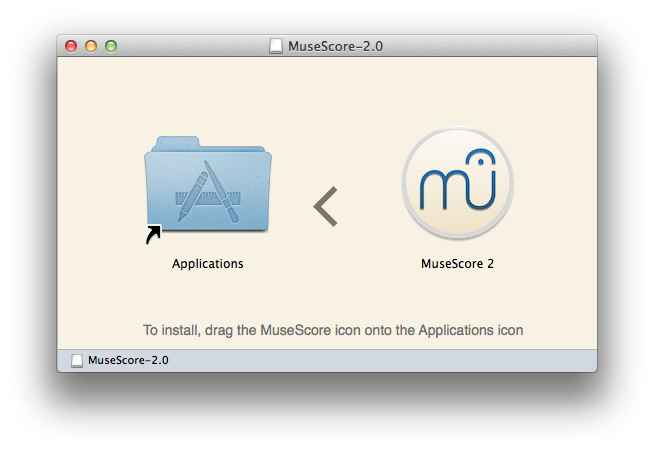
Drag and drop the MuseScore icon to the Applications folder icon.
If you are not logged in as administrator, macOS may ask for a password: click Authenticate and enter your password to proceed.
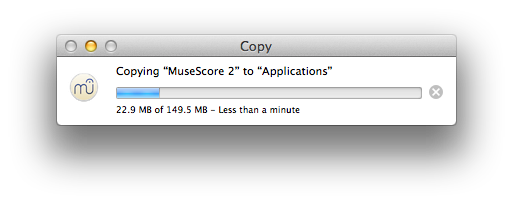
When the application has finished copying, eject the disk image. You can now launch MuseScore from the Applications folder, Spotlight, or Launchpad.
Uninstall
Simply delete MuseScore from Applications folder.
Install with Apple Remote Desktop
You can deploy MuseScore to multiple computers with the "Copy" feature of ARD. Since MuseScore is a self-contained application you can simply copy the application to the '/Application' folder on the target machines. It is also possible to install multiple versions of the application as long as their names differ.
External links
Install on Linux
As of MuseScore 2.0.3 you can, for the first time, get hold of a copy for Linux straight from the download page, just like Windows and Mac users. This is possible thanks to the AppImage packaging format, which runs on pretty much all Linux distributions. If you prefer, there is still the option to get it the traditional way via your distribution's package manager (but you may have to wait for it to get packaged by the relevant maintainer). Of course, you can always build from source.
AppImage
The AppImage format is a new way of packaging Linux applications. AppImages are portable - they don't have to be installed - and they run on pretty much any Linux distribution. Dependencies are included in the one AppImage file.
Step 1 - Download
Before you download an AppImage, you need to know your processor's architecture. These terminal commands will show it:
archor
uname -m
The output will be something like "i686", "x86_64" or "armv7":
i686(or similar) - 32-bit Intel/AMD processor (found on older machines).x86_64(or similar) - 64-bit Intel/AMD processor (modern laptop and desktop computers, most Chromebooks).armv7(or later) - ARM processor (phones & tablets, Raspberry Pi 2/3 running Ubuntu Mate, some Chromebooks, usually 32-bit at present).
Now you can head over to the download page and find the AppImage that best matches your architecture. Once downloaded, the file will be named "MuseScore-X.Y.Z-$(arch).AppImage".
Step 2 - Give execute permission
Before you can use the AppImage you need to give permission for it to be run as a program.
From the Terminal:
This command gives the user (u) permission to execute (x) the AppImage. It works on all Linux systems.
cd ~/Downloads chmod u+x MuseScore*.AppImage
Note: Use the "cd" command to change directory to wherever you saved the AppImage.
From a File Manager:
If you prefer to avoid the command line, there is usually a way give execute permission from inside a File Manager.
In GNOME Files (Nautilus), simply:
- Right-click on the AppImage and select "Properties".
- Open the "Permissions" tab.
- Enable the option labelled "Allow executing file as a program".
The process may be slightly different in other file managers.
Step 3 - Run it!
Now you should be able to run the program simply by double-clicking on it!
When you downloaded the AppImage it was probably saved in your Downloads folder, but you can move somewhere else it at any time (e.g. you could put it on your desktop for easy access). If you ever want to remove it then simply delete it.
Installing the AppImage (optional)
You can run the AppImage without installing it, but you must install it if you want it to be completely integrated with your desktop environment. This has the following benefits:
- Adds the AppImage to your Applications Menu or Launcher
- Sets the correct icons for MuseScore's files (MSCZ, MSCX) and for MusicXML files (MXL, XML)
- Makes the AppImage available via your File Manager's right-click "Open with..." menu
To install it, run the AppImage from the Terminal with the "install" option (see immediately below). This copies a desktop file and various icons to your computer. If you want to remove them you will need to run the "remove" option before you delete the AppImage. This does not affect any scores created with any version of MuseScore.
Using command line options
Running the AppImage from the Terminal allows you to use various command line options. The AppImage has some special options in addition to MuseScore's normal command line options.
You will need to change directory (cd) to wherever the AppImage is saved your system, for example:
cd ~/Desktop ./MuseScore*.AppImage [option...]
Or give the path to the AppImage:
~/desktop/MuseScore*.AppImage [option...]
Use the "--help" and "man" options to get more information about the available command line options:
./MuseScore*.AppImage --help # displays a complete list of command line options ./MuseScore*.AppImage man # displays the manual page (explains what the options do)
Distribution Packages
Fedora
-
Import the GPG key:
su rpm --import http://prereleases.musescore.org/linux/Fedora/RPM-GPG-KEY-Seve
-
Go to the download page of the MuseScore website. Click on the link for the stable Fedora download and choose the correct rpm package for your architecture.
-
Depending on your architecture, use one of the two sets of commands to install MuseScore
-
for arch i386
su yum localinstall musescore-X.Y-1.fc10.i386.rpm
-
for arch x86_64
su yum localinstall musescore-X.Y-1.fc10.x86_64.rpm
-
If you have difficulty with sound, see Fedora 11 and sound.
See also the hints for the various distributions on the download page.
External links
Install on Chromebook
Desktop program
MuseScore's desktop program will not work natively on Chrome OS, but there are some workaround solutions:
-
Since Chrome OS 69, certain chromebook models are able to run Linux apps and so you can install MuseScore for Linux as provided on our Download page. Feedback about the installation process and supported hardware is welcome on the forum
-
Via software-on-demand service such as rollApp: By just visiting this website, you can run MuseScore in the browser. You can access your scores via cloud services such as Google Drive or save them to your online MuseScore account through the menu File→Save Online.... Note that currently, sound and playback does not work on rollApp.
-
Via Crouton: Involves installing a Linux based operating system which runs in parallel with Chrome OS, and then installing MuseScore on Linux.
Android app (playback only)
Alternatively, it is possible to install MuseScore's Android app on recent Chromebooks. You will need to update to the latest version of Chrome OS first. See the Chromebook support documentation for help installing Android apps on Chromebooks, and a list of supported devices. The app only supports playback of existing scores, not score editing or creation, but you can sign-in to your MuseScore account for easy access to all your scores on MuseScore.com.
External links
- How to run MuseScore on a Chromebook
- Check the installation procedure from the comments in this thread
- How to change the language in MuseScore
Taalinstellingen en bijwerken van de vertalingen
MuseScore is geïnstalleerd en werkt met de Systeem-taal van het besturingssysteem.
Deze taal is afhankelijk van het land, de taalinstellingen op de PC en de gebruiker (de meeste programma's maken gebruik van deze taal)
Taal wijzigen
1.Kies: Bewerken → Voorkeuren... (Mac: MuseScore → Voorkeuren...)
2. In de tab Algemeen ziet u een sectie Taal:
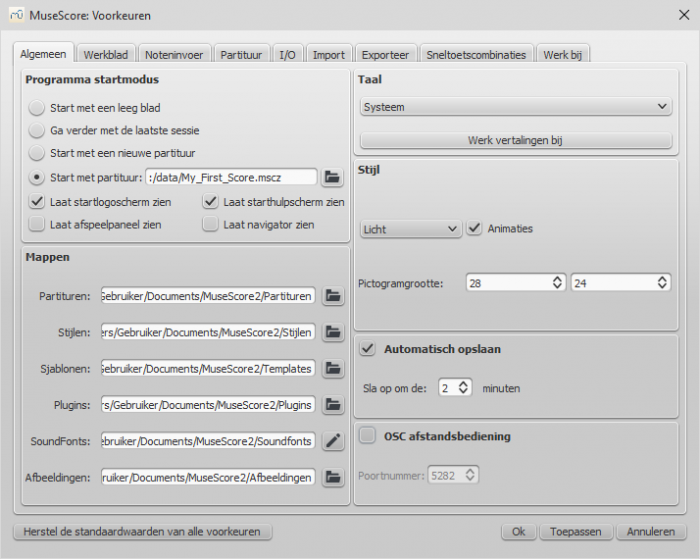
Hier kun je een andere taal kiezen uit een lijst en eventuele bijgewerkte versie van de vertaling downloaden met de knop: Werk vertalingen bij
Een nieuw venster verschijnt, met de door gekozen taal bovenaan. - Zie verder.
Zoals aangegeven moet je MuseScore afsluiten en opnieuw opstarten om de wijziging door te voeren.
Bijwerken vertalingen
Je kunt de vertalingen bijwerken via Bewerken --> Voorkeuren... (zoals hierboven beschreven), maar er is ook een andere methode:
- Ga naar Help → Databronnen-beheer...
-
Klik op de knop "Werk bij" van uw keuze
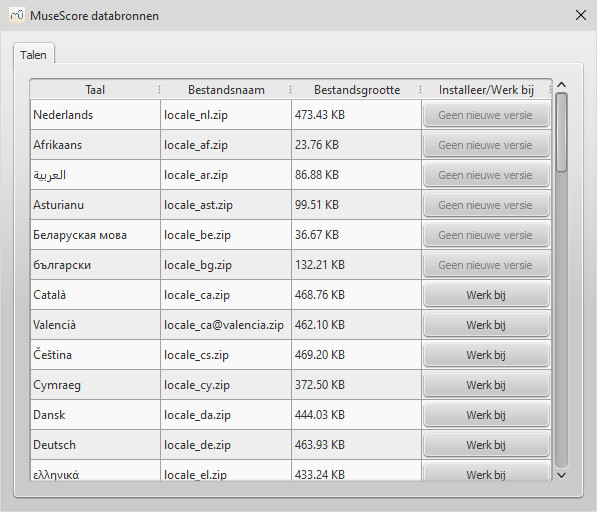
Ook hier moet je MuseScore afsluiten en opnieuw opstarten om de wijziging door te voeren.
Zie ook
Controleren op nieuwe versie
Er zijn twee manieren om op nieuwe versies te controleren.
Automatische controle
- Kies: Bewerken → Voorkeuren... (Mac: MuseScore → Voorkeuren...)
- Selecteer de tab Werk bij
-
Vink aan: Controleer op een nieuwe versie van MuseScore
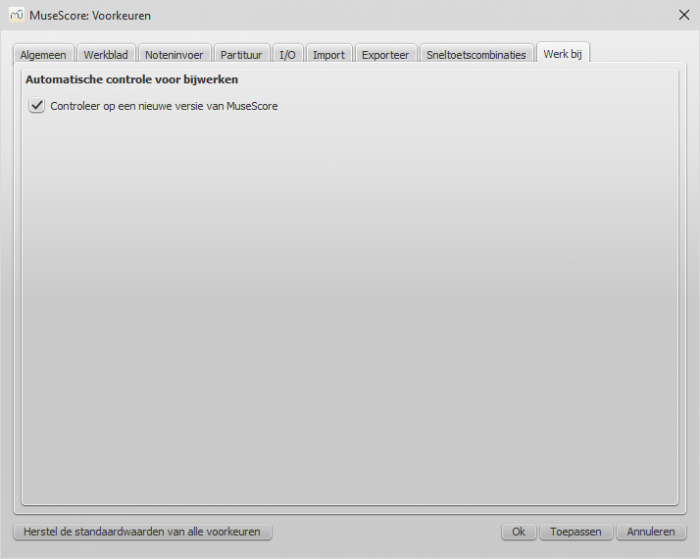
Voortaan zal MuseScore bij iedere opstart controleren op nieuwe versies en indien nodig een melding geven als er een nieuwe versie beschikbaar is.
Handmatige controle
-
Selecteer Help → Controleer op nieuwe versie

-
Er verschijnt een dialoogvenster met vermelding van de status: ofwel "Geen nieuwe versie beschikbaar" ofwel "Een nieuwe versie voor MuseScore is beschikbaar:" gevolgd door een link om deze te downloaden.